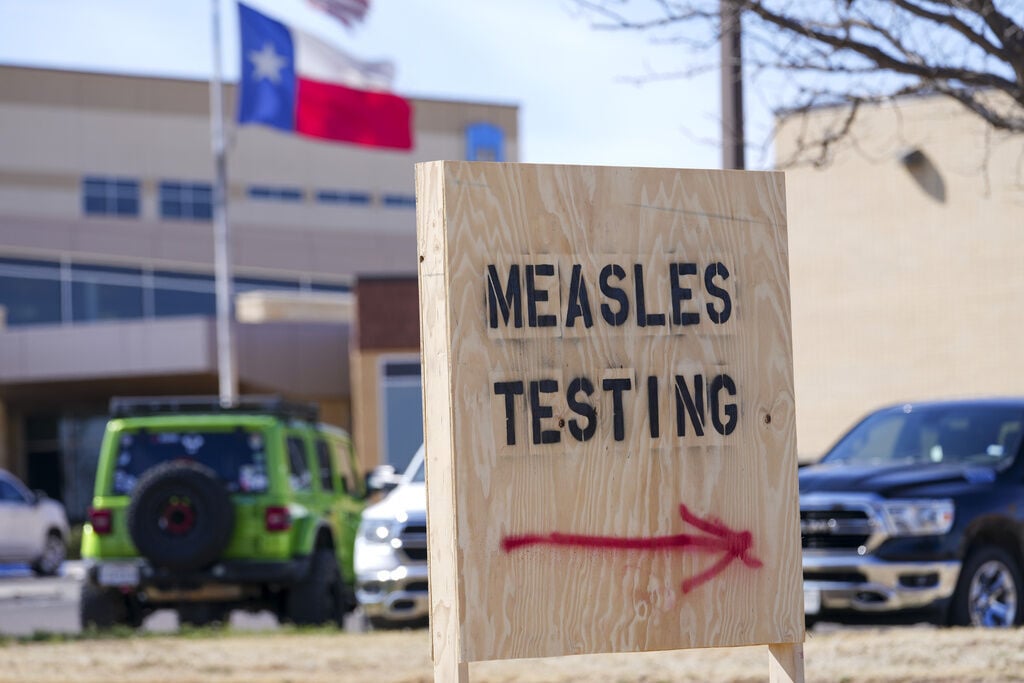Caroline Neal
RACINE — As measles spreads through communities in Texas, New Mexico and other states, Racine and Kenosha vaccination rates remain below the necessary 95% vaccination threshold for herd immunity.
A report from the Centers of Disease Control and Prevention found that Wisconsin children had the second lowest measles vaccination rate at 84.8%, with only Alaska ranking lower at 84.3%.
As of March 14, the United States has seen 301 cases of measles, 95% of which were unvaccinated or did not have a known vaccination status.
In February, an unvaccinated school-aged child in Texas died from measles, marking the first U.S. death from the disease in a decade. An adult infected with measles in New Mexico also died, but the cause of death is still being investigated.

DeMuri
“We’re just waiting for it to hit Wisconsin,” said Dr. Greg DeMuri, a professor in the Division of Infectious Diseases at the University of Wisconsin. “It’s really spreading throughout the United States. This has happened before, even with higher vaccination rates. It’s happened because we haven’t hit that magic 95%.”
What is measles?
According to the CDC, measles is a disease that can cause high fever; cough; runny nose; red, watery eyes; and a rash. It can occur at any time of the year.

An electron microscope image of a measles virus particle. As of March 14, there have been a total of 301 confirmed measles cases in the United States, with most being in Texas and New Mexico
Spreading through the air, measles is one of the most highly contagious diseases of the vaccine-preventable diseases and those most people are familiar with, DeMuri said.
“One way to conceptualize that is if you’re on an airplane and you’re sitting in first class, and somebody has measles in the rear of the plane, you can get measles from breathing air that’s recirculated through that airplane,” he said. “It’s not just sitting close to them, getting coughed on, that kind of thing, like it is with flu.”
Although Texas and New Mexico are far away from Wisconsin, proximity matters less now, DeMuri said.
“It only takes a traveler from a place where there’s been a case. Somebody visits family members in another state where there’s a case, brings it back home,” he said. “You’re contagious before you develop the rash and before you get sick, and so it can be spread to others silently.”
At a local level
Data from the Wisconsin Department of Health Services shows that in 2023, 74% of 5- and 6-year-old children in Racine County had received two or more doses of the measles, mumps and rubella vaccine.
That same year, 69% of 5- and 6-year-old children in Kenosha County had received two or more doses of MMR.
For DeMuri, counties with low vaccination rates like Racine and Kenosha are “ticking time bombs.”
“The virus is really knocking at our door,” he said.
Racine and Kenosha do not have the lowest vaccination rates in the state: The same data showed Vernon County at 48%, and Clark County is at 46%.
Though other counties have lower rates, many also benefit from being rural and more spread out, whereas residents from Racine and Kenosha frequently travel between the two.
“It’s going to cause a lot of leakage of virus over from one to another,” DeMuri said. “If it does hit either one, it’s going to be pretty quick before the other is going to get it.”
Schools at risk
Schools, too, are at risk for outbreaks.
According to the CDC, there is a higher chance of an outbreak in schools with more unvaccinated children, and the outbreak size increases with the percent of unvaccinated children.
Each year, Wisconsin schools are required to report how many students have met the minimum immunization requirements, are in the process of meeting requirements, are behind schedule, have a waiver, or have no immunization record or waiver.
DHS data from the 2023-24 school year shows that 86% of all Racine Unified School District students met the minimum vaccination requirements, and the remaining are in progress, are behind schedule or have a waiver.
Still, 92.54% were in compliance with state immunization law, which allows students to be in the process of receiving their vaccinations or have a signed waiver.
Stacy Tapp, chief of communication and community engagement at RUSD, said the district does not have a plan “at this time” to increase the percent of students in compliance with state immunization laws.
According to the Racine County Public Health Division, just over 5% of students in the county requested immunization waivers, marking an increase of almost a full percent from the 2019-20 school year to the 2024-25 school year.
“Non-medical waivers are the largest contributor, accounting for almost 90% of all student immunization waivers in 2024-2025 across Racine County,” a Racine County spokesperson said.
Of Kenosha Unified School District students, 88% have met the minimum requirements, and the remaining are in progress, are behind schedule, or have requested a waiver. However, 99.26% of KUSD students are in compliance with state law.
According to KUSD, there has been an increase in waivers for religious, medical or personal convictions, which are permitted within state immunization requirements.
Indeed, DHS data shows 6.1% of Wisconsin students during the 2023-24 school year have a waiver.
“It is important to keep in mind that waivers typically increase when the state requirements change,” a KUSD spokesperson said. Over the past few years, Wisconsin’s requirements have changed. “It appears that waivers tend to increase during the years when these types of changes occur.”
KUSD sends notices on the 15th and 20th days of school when students are not in compliance.
The district sends electronic communications through Virtual Backpack, its family e-newsletter, and its student information system as well as flyers from the Kenosha County Public Health Department on childhood immunizations.
In the spring, KUSD sends reminders to guardians for the next school year.
Spread of misinformation
In a statement, Kenosha County’s communication director Joe Potente said “Health Officer Lori Plahmer reports that the county is continuing to conduct its normal surveillance and that we currently have no reported (measles) cases here.”
According to Racine County Public Health Division, low MMR vaccination rates in Wisconsin are a “significant concern.”
Racine County Public Health has run PSAs to spread accurate information and to encourage people to stay current on vaccinations.
The county also informs families through its home visiting programs, during which a nurse or educator answers questions and helps families make a plan to get up to date on vaccines.
“We encourage families to get their vaccines at their healthcare providers office, local health departments, or local pharmacies,” the county said. “We also offer vaccines for uninsured or underinsured children at our clinic in Sturtevant.”
According to DeMuri, declining vaccination rates can be attributed to a combination of factors, including misinformation on social media that has caused a swing in attitudes against vaccines.
“There’s been this really promulgation of vaccine information throughout social media, and that just propagates,” DeMuri said. “People send it to their kids, their grandchildren, their brother, sister, and then that misinformation gets out there.”
For DeMuri, one way local officials can combat misinformation is “meeting people where they are” and running social media campaigns.
The Covid-19 pandemic also played a role in this, he said, because there was more misinformation about vaccinations.
“That has bled over into mistrust for other vaccines,” said DeMuri, adding that he’s noticed declining vaccination rates for other vaccines, especially for live vaccines like MMR that are more prone to misinformation.
Following the work of Andrew Wakefield in the 1990s, MMR has also been “picked on” as a possible cause of autism, he said.
“(Wakefield’s) work was completely discredited,” DeMuri said. “There have been multiple, large-scale epidemiologic studies from very, very trustworthy researchers that have shown there’s absolutely no risk between measles vaccine and autism.”
DeMuri also recommends people talk with their health care providers.
“Go to your doctor, your nurse practitioner, physician’s assistant — you trust them with your life, really — and ask their opinion about this,” he said.
A Racine County spokesperson said vaccine hesitancy among adults is “likely the biggest contributing factor” to low vaccination rates in the county.
“We as a society are inundated with information and it is often difficult to filter out misinformation and identify reputable sources. It only takes a seed of doubt to potentially sway someone’s decision to vaccinate,” Racine County Public Health Division wrote. “It is our goal to be the source of trusted information for our community so they can make the best decision possible for themselves and their families.”






No comments:
Post a Comment